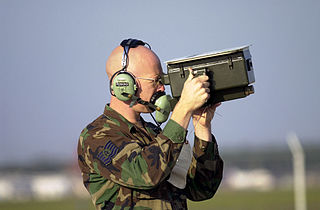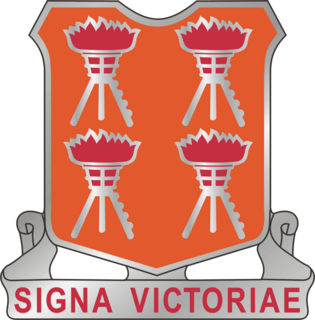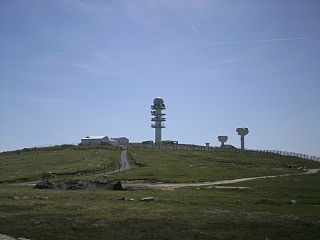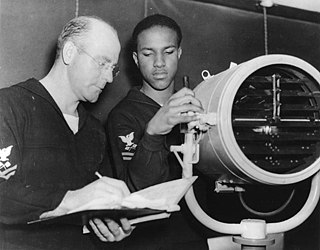 W
WMilitary communications or military signals involve all aspects of communications, or conveyance of information, by armed forces. Military communications span from pre-history to the present. The earliest military communications were delivered by runners. Later, communications progressed to visual and audible signals, and then advanced into the electronic age. Examples from Jane's Military Communications include text, audio, facsimile, tactical ground-based communications, naval signalling, terrestrial microwave, tropospheric scatter, satellite communications systems and equipment, surveillance and signal analysis, security, direction finding and jamming.
 W
WAdvanced Extremely High Frequency (AEHF) is a series of communications satellites operated by the United States Space Force. They will be used to relay secure communications for the Armed Forces of the United States, the British Armed Forces, the Canadian Armed Forces, the Royal Netherlands Armed Forces and the Australian Defence Force. The system will consist of six satellites in geostationary orbits. The final satellite was launched on 26 March 2020. AEHF is backward compatible with, and will replace, the older Milstar system and will operate at 44 GHz Uplink and 20 GHz Downlink. The AEHF system is a joint service communications system that will provide survivable, global, secure, protected, and jam-resistant communications for high-priority military ground, sea and air assets.
 W
WAdvanced Extremely High Frequency (AEHF) is a series of communications satellites operated by the United States Space Force. They will be used to relay secure communications for the Armed Forces of the United States, the British Armed Forces, the Canadian Armed Forces, the Royal Netherlands Armed Forces and the Australian Defence Force. The system will consist of six satellites in geostationary orbits. The final satellite was launched on 26 March 2020. AEHF is backward compatible with, and will replace, the older Milstar system and will operate at 44 GHz Uplink and 20 GHz Downlink. The AEHF system is a joint service communications system that will provide survivable, global, secure, protected, and jam-resistant communications for high-priority military ground, sea and air assets.
 W
WAirborne Launch Control Centers provide a survivable launch capability for the United States Air Force's LGM-30 Minuteman Intercontinental Ballistic Missile (ICBM) force by utilizing the Airborne Launch Control System (ALCS) onboard which is operated by an airborne missileer crew. Historically, from 1967–1998, the ALCC mission was performed by United States Air Force Boeing EC-135 command post aircraft. This included EC-135A, EC-135C, EC-135G, and EC-135L aircraft.
 W
WThe Airborne Launch Control System (ALCS) provides a survivable launch capability for the United States Air Force's LGM-30G Minuteman III intercontinental ballistic missile (ICBM) force. The ALCS is operated by airborne missileers from Air Force Global Strike Command's (AFGSC) 625th Strategic Operations Squadron (STOS) and United States Strategic Command (USSTRATCOM). The weapon system is located on board the United States Navy's E-6B Mercury, which serves as USSTRATCOM's "Looking Glass" Airborne Command Post (ABNCP). The ALCS crew is integrated into the ABNCP battle staff and is on alert around the clock.
 W
WThe Allied military phonetic spelling alphabets prescribed the words that are used to represent each letter of the alphabet, when spelling other words out loud, letter-by-letter, and how the spelling words should be pronounced for use by the Allies of World War II. They are not a "phonetic alphabet" in the sense in which that term is used in phonetics, i.e. they are not a system for transcribing speech sounds.
 W
WBlue light is an archaic signal, the progenitor of modern pyrotechnic flares. Blue light consists of a loose, chemical composition burned in an open, hand-held hemispherical wooden cup, and so is more akin to the flashpan signals of the Admiral Nelson era than the modern, encased signal flares, often launched by mortar or rifle and suspended by parachute. Widely used during the eighteenth and nineteenth centuries for signaling by the world's military forces, and for general illumination in the civilian sector, blue light was remarkable for its use of poisonous arsenic compounds, which contributed to its replacement by safer flares in the early twentieth century.
 W
WThe Boeing EC-135 is a retired command and control variant of the Boeing C-135 Stratolifter. During the Cold War, the EC-135 was best known for being modified to perform the Looking Glass mission where one EC-135 was always airborne 24 hours a day to serve as flying command post for the Strategic Air Command in the event of nuclear war. Various other EC-135 aircraft sat on airborne and ground alert throughout the Cold War, with the last EC-135C being retired in 1998. The EC-135N variant served as a tracking aircraft for the Apollo program.
 W
WCheget is a "nuclear briefcase" and a part of the automatic system for the command and control of Russia's Strategic Nuclear Forces (SNF) named Kazbek.
 W
WA command center is any place that is used to provide centralized command for some purpose.
 W
WThe Communications and Electronics Branch is a personnel branch of the Canadian Armed Forces (CAF). The army component of the branch is designated the Royal Canadian Corps of Signals.
 W
WCommunications School is where selected United States Marine Corps commissioned and warrant officers are sent to learn the art and science of planning and employing communications and performing command and staff duties.
 W
WCommunications security is the discipline of preventing unauthorized interceptors from accessing telecommunications in an intelligible form, while still delivering content to the intended recipients.
 W
WCounter-IED equipment are created primarily for military and law enforcement. They are used for standoff detection of explosives and explosive precursor components and defeating the Improvised Explosive Devices (IEDs) devices themselves as part of a broader counter-terrorism, counter-insurgency, or law enforcement effort.
 W
WThe Crypto Wars is an unofficial name for the U.S. and allied governments' attempts to limit the public's and foreign nations' access to cryptography strong enough to resist decryption by national intelligence agencies.
 W
WThe Defense Satellite Communications System (DSCS) is a United States Space Force satellite constellation that provides the United States with military communications to support globally distributed military users. Beginning in 2007, DSCS is being replaced by the Wideband Global SATCOM system. A total of 14 DSCS-III satellites were launched between the early 1980s and 2003. Two satellites were launched aboard the Space Shuttle Atlantis in 1985 during the STS-51-J flight. As of 23 November 2015, seven DSCS-III satellites were still operational. DSCS operations are currently run by the 4th Space Operations Squadron out of Schriever Air Force Base.
 W
WAn electronic countermeasure (ECM) is an electrical or electronic device designed to trick or deceive radar, sonar or other detection systems, like infrared (IR) or lasers. It may be used both offensively and defensively to deny targeting information to an enemy. The system may make many separate targets appear to the enemy, or make the real target appear to disappear or move about randomly. It is used effectively to protect aircraft from guided missiles. Most air forces use ECM to protect their aircraft from attack. It has also been deployed by military ships and recently on some advanced tanks to fool laser/IR guided missiles. It is frequently coupled with stealth advances so that the ECM systems have an easier job. Offensive ECM often takes the form of jamming. Self-protecting (defensive) ECM includes using blip enhancement and jamming of missile terminal homers.
 W
WIn military telecommunications, the terms electronic support (ES) or electronic support measures (ESM) describe the division of electronic warfare involving actions taken under direct control of an operational commander to detect, intercept, identify, locate, record, and/or analyze sources of radiated electromagnetic energy for the purposes of immediate threat recognition or longer-term operational planning. Thus, electronic support provides a source of information required for decisions involving electronic protection (EP), electronic attack (EA), avoidance, targeting, and other tactical employment of forces. Electronic support data can be used to produce signals intelligence (SIGINT), communications intelligence (COMINT) and electronics intelligence (ELINT).
 W
WField telephones are telephones used for military communications. They can draw power from their own battery, from a telephone exchange, or from an external power source. Some need no battery, being sound-powered telephones.
 W
WThe Global Information Grid (GIG) is an all-encompassing communications project of the United States Department of Defense.
 W
WIdentification, friend or foe (IFF) is a radar-based identification system designed for command and control. It uses a transponder that listens for an interrogation signal and then sends a response that identifies the broadcaster. It enables military and civilian air traffic control interrogation systems to identify aircraft, vehicles or forces as friendly and to determine their bearing and range from the interrogator. IFF may be used by both military and civilian aircraft. IFF was first developed during World War II, with the arrival of radar, and several friendly fire incidents.
 W
WInformation Technology Specialist or Information Systems Operator-Analyst is a Military Occupational Specialty (MOS) in the United States Army. Information Technology Specialists have the responsibility of maintaining, processing and troubleshooting military computer systems and operations.
 W
WThe Military Wireless Museum is a private museum operated from Kidderminster, Worcestershire which displays a collection of military wireless equipment from around the world. It developed from the private collection of Ben Nock and marks the importance of wireless communications in the UK and around the globe during World War II and later years.
 W
WIn computer networking, MILNET was the name given to the part of the ARPANET internetwork designated for unclassified United States Department of Defense traffic.
 W
WThe International Radiotelephony Spelling Alphabet, commonly known as the NATO phonetic alphabet or the ICAO phonetic alphabet, is the most widely used radiotelephone spelling alphabet. The ITU phonetic alphabet and figure code is a variant.
The Pakistan Army Corps of Signals (Urdu: ﺁرمى سگنل كور; Army Signal Core, is an active combatant military administrative staff corps and a major intelligence, science and technology command of Pakistan Army. The corps core objectives includes research and development, tests, and management of the military communications and information systems support for the command and control of the combined arms forces.
 W
WIn the Finnish Army, a Partiosanomalaite m/83 (Parsa) is a compact communications device for reconnaissance units. The device can send free- and limited length messages, but writing is more inconvenient than with a proper messaging device, for example for communicating fire commands two buttons need to be pressed.
 W
WThe Pierre-sur-Haute military radio station is a 30-hectare (74-acre) site used for French military communications. It has been used in the service of France since 1913. It is in the Sauvain and Job communes, with the boundary between the Rhône-Alpes and Auvergne regions passing through the site. There are three towers at the site. The tallest one is a 55-metre-high civilian telecommunication tower owned by Télédiffusion de France. The facility its at the summit of Pierre-sur-Haute at an elevation of 1,634 metres (5,361 ft), about 6 kilometres (3.7 mi) from the village of Chalmazel. There is a small ski resort near the radio station, with the top of the quad lift sitting less than 300 metres (980 ft) from the station fence.
 W
WA recognition signal is a signal whereby a person, a ship, an airplane or something else is recognized. They can be used during war or can be used to help the police recognize each other during undercover operations. It can also be used in biology to signal that a molecule or chemical is to be bound to another molecule.
 W
WA runner was a military courier, a foot soldier responsible for carrying messages during war. Runners were very important to military communications, before telecommunications became commonplace.
 W
WA signal lamp is a semaphore system using a visual signaling device for optical communication, typically using Morse code.
 W
WThe Sri Lanka Signals Corps (SLSC) is a combat support corps of the Sri Lanka Army, responsible for providing military communications, information technology and electronic warfare support. The corps is made up of a signals brigade, ten regular regiments and one volunteer regiment. It is responsible for installing, maintaining and operating all types of telecommunications equipment and information systems. It is headquartered at the Panagoda Cantonment.
 W
WA tactical data link (TDL) uses a data link standard in order to provide communication via radio waves or cable used by the U.S. armed forces and NATO nations. All military C3 systems use standardized TDL to transmit, relay and receive tactical data.
 W
WThe Ultra High Frequency Follow-On (UFO) system is a United States Department of Defense (DOD) program sponsored and operated by the U.S. Navy to provide communications for airborne, ship, submarine and ground forces. The UFO constellation replaced the U.S. DOD Fleet Satellite Communications System (FLTSATCOM) constellation and will consist of eleven satellites. The ground terminal segment consists of equipment and resident personnel at existing satellite communication stations. The spacecraft are controlled by the Naval Satellite Operations Center (NAVSOC) located at the Naval Base Ventura County, Point Mugu, CA.
 W
WThe first incarnation of Westinghouse Electric Corporation, an American manufacturing company, was founded on January 8, 1886, by George Westinghouse. It was originally named Westinghouse Electric & Manufacturing Company, and was renamed Westinghouse Electric Corporation in 1945. The company acquired the CBS television network in 1995, and was renamed into the first incarnation of CBS Corporation before being acquired by Viacom in 1999.